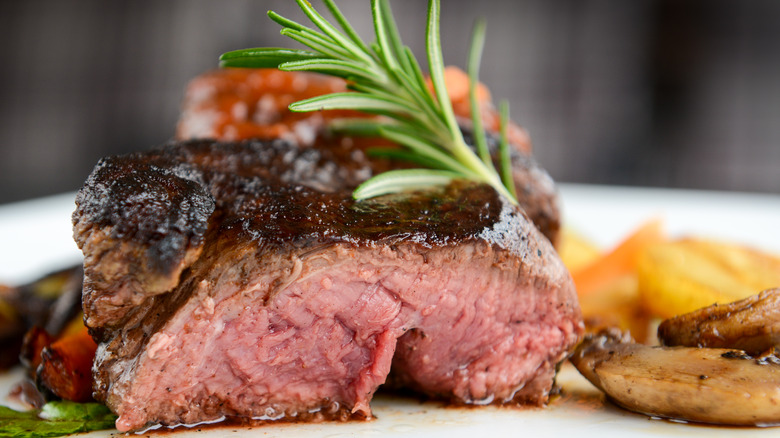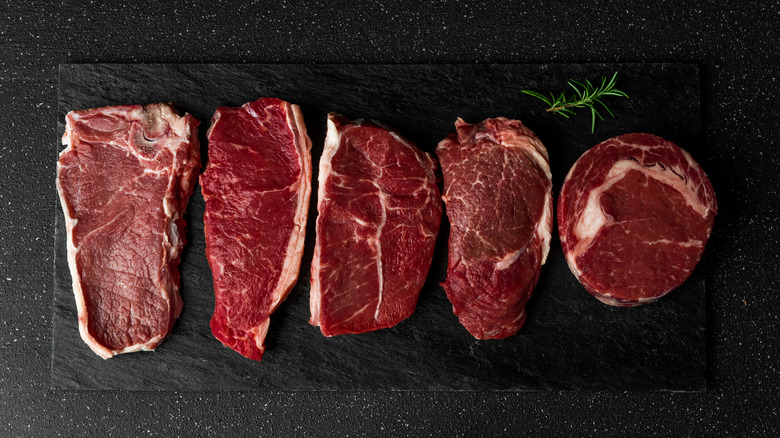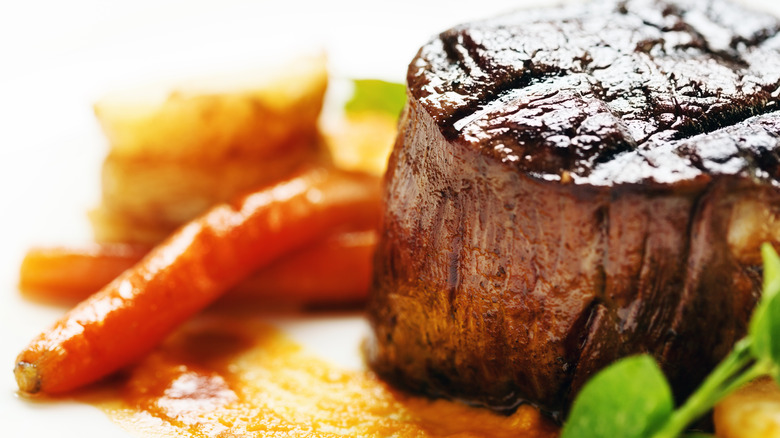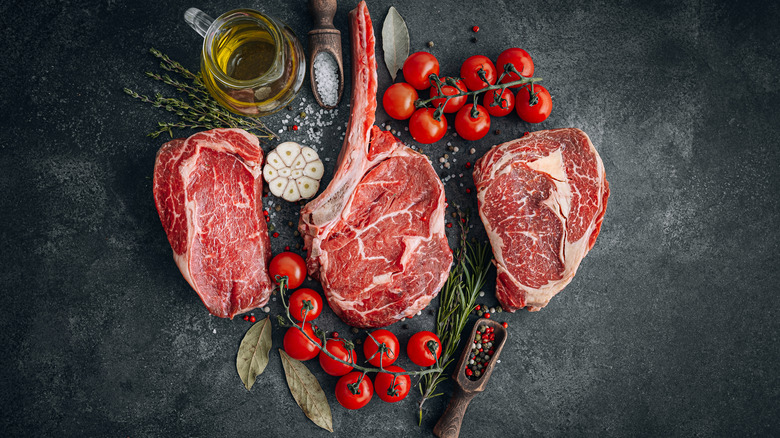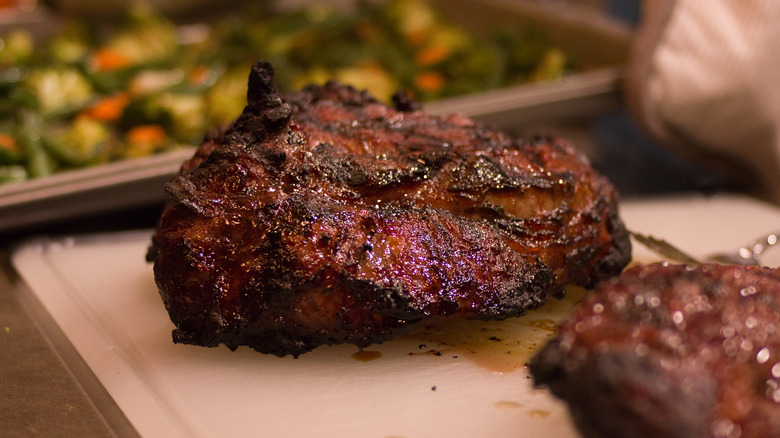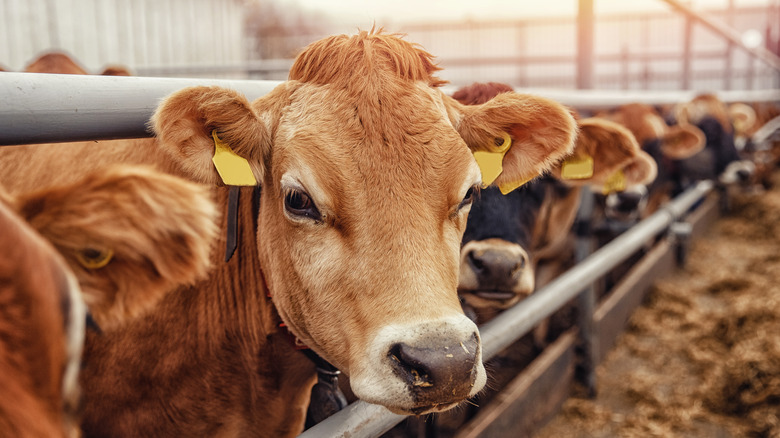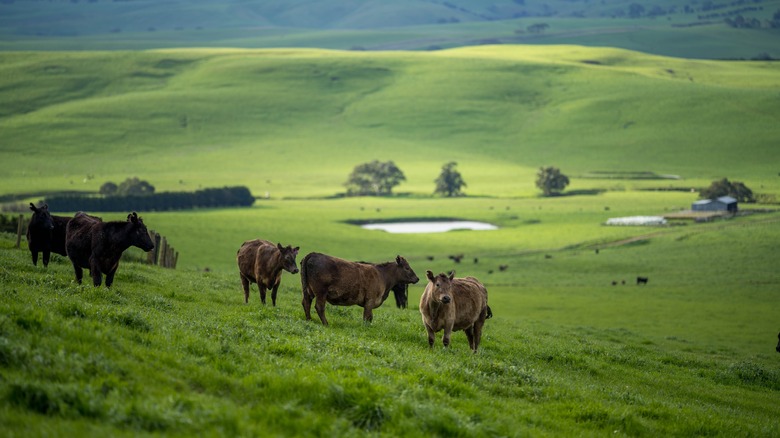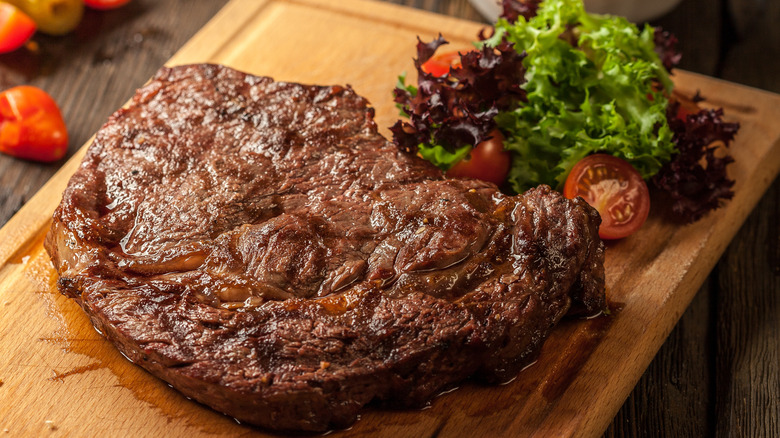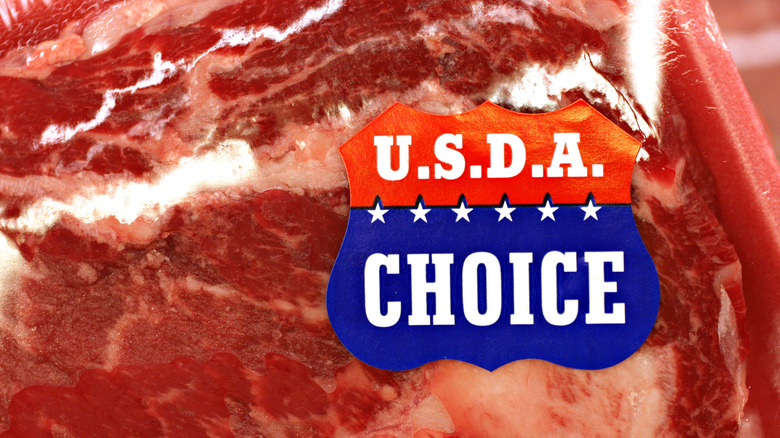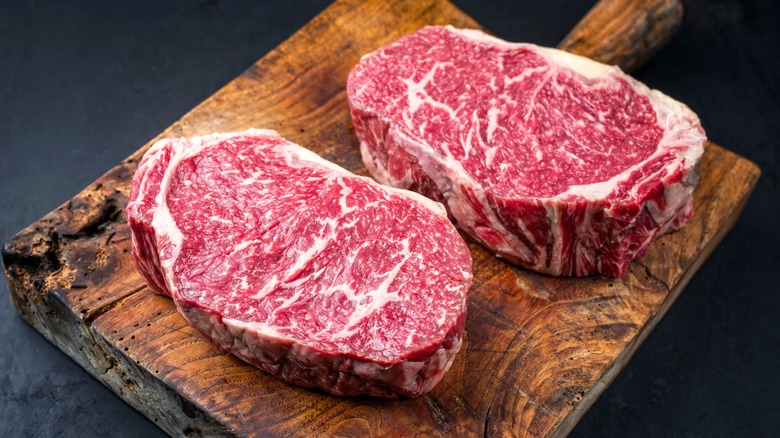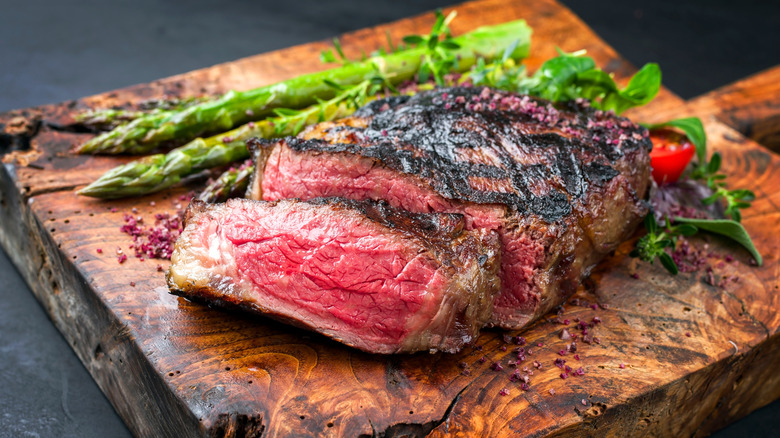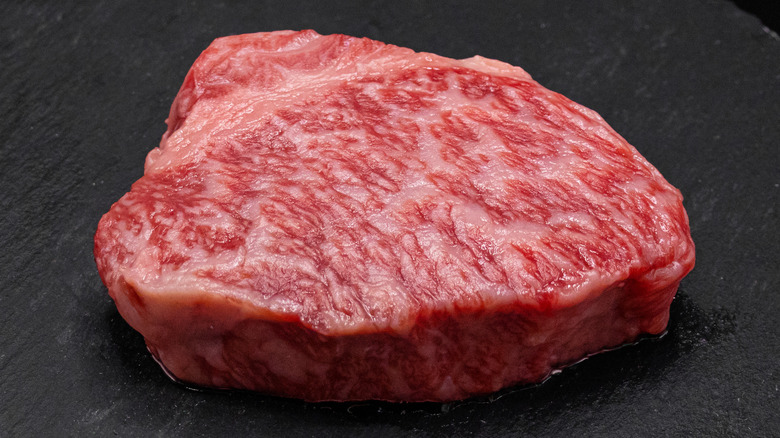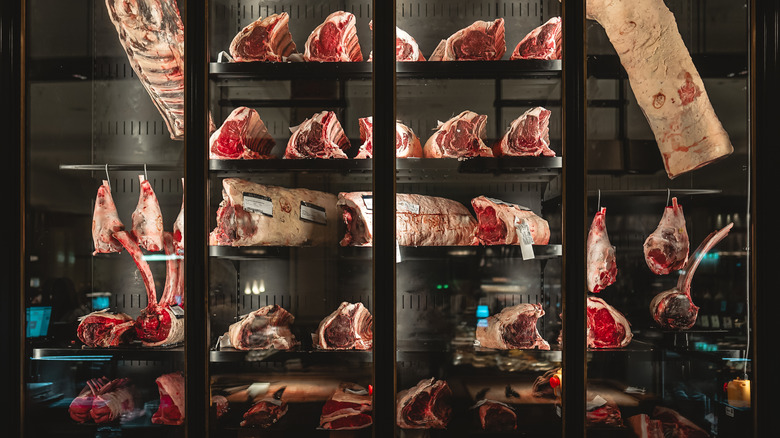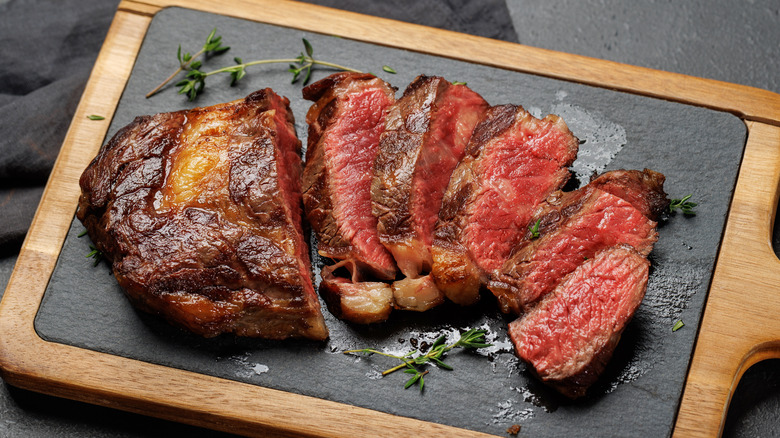How To Tell If You're Eating A Cheap Vs. An Expensive Steak
The popularity of steak and steakhouses in our modern world might lead you to believe that steak is a modern food, but it's actually been around since at least the mid-15th century when the words "steik," "stickna," and "steikja" were used to describe thick cuts of meat. It's likely that even before that time the food was being eaten — if called by a different name. Still, for a food that's been around for so long, steak is a favorite among people who eat meat.
Despite steak's longevity and preferred status over other types of meat, the average person doesn't really understand what constitutes a cheap versus an expensive steak, other than the price they see at the butcher, grocery store, or on a restaurant menu. Whether it's a particular cut of steak, a particular type of cow, the aging process, the USDA rating, or something altogether different, we're here to break down how to tell whether the steak you're eating is a cheap or expensive one, based on more than just the price you've been given.
Steak can come from different cuts on a cow
While the word steak is not exclusive to beef (after all, there are tuna steaks, salmon steaks, venison steaks, and more), most of us think of beef when we think about steak and that's what we're talking about here. Even within the realm of beef steak, there are many different cuts available and each cut has some unique characteristics that help determine not only the flavor of the meat and how it's used, but also the price of said steak.
It's well known that different cuts of steak come from different parts of the cow. Sirloin, for instance, is the top part of the cow's back and also includes top sirloin and center-cut sirloin cuts as well as tri-tip steak. The short loin, on the other hand, includes cuts like the T-bone, porterhouse, filet mignon, tenderloin, and hanger steak. Ribeye and cowboy steaks come from the cow's rib section while the round includes rump roast, round roast, and top round steak.
Tender meat equals a higher price
One thing that many expensive steaks have in common is that they're tender. When you eat a steak, you don't want to have to chew it for ages. It's why "melts in your mouth" is such a successful marketing tactic when it comes to steak. That's what we want in an expensive steak, something that is tender, succulent, and a delight to eat.
It is certainly possible to tenderize a steak using a marinade, the most naturally tender cuts on a cow tend to come from the rib and loin, so T-bone, porterhouse, filet mignon, tenderloin, and ribeye all fall in that category. They're expensive because of that natural tenderness and because they account for so little of the cow in the grand scheme of things. Butchers hike up the price on these cuts both because consumers are willing to pay for it and because they'd otherwise lose money on the rest of the cow that isn't so naturally tender and delicious.
Muscle use helps determine tenderness
While we know that the naturally tender cuts of beef bring in higher prices, you'd be well within your rights to wonder what it is about those cuts of beef that make them so naturally tender. The answer lies in where those cuts are positioned on the cow's body and how often the muscle is used.
When a muscle is used a lot, more collagen builds up in it. Collagen is what makes the muscle strong and also what can make it tough. In short, the less a muscle is used, the less collagen it will have and the more tender it will be. This means that supportive muscles like the loin (which runs from the cow's neck to hip along the spine) and the rib aren't used as much as the legs, shoulders, and haunches, making cuts from the less-used muscles more tender and, therefore, more expensive.
Gristle is a sign of a cheaper cut
While collagen in steak is a sign of muscle use and can be broken down with a marinade or with certain cooking methods, there's another type of connective tissue in steak that can't be broken down no matter how long you marinate your steak and that's elastin, also called gristle or cartilage.
Because elastin is a connective tissue that helps muscle and bone work together, it is found more frequently in the same muscles that are high in collagen — those that are weight-bearing and predominantly used for movement. So, while you (or a restaurant chef) may be able to reduce the amount of collagen in a steak (making it more tender), there's not a lot that can be done about gristle other than cutting it out. So, if you're finding a lot of gristle in your otherwise tender steak it's a sure sign you've got a cheap cut that's been tenderized after the fact.
Factory farming impacts more than just cost
If you've ever wondered why the same cut of steak is less expensive from the big chain grocery store than from your local butcher, the answer is probably factory farming. This type of commercial farming accounts for an estimated 90% of farmed animals globally, including 74% of land animals like chickens, hogs, dairy cows, and beef cattle. In the United States, the estimate is closer to 99% of farmed animals. Because more beef can be raised on factory farms, the overall price of your factory-farmed steaks will be lower, but there are other costs associated with factory farming.
After their first year of life, factory-farmed beef cattle spend the rest of their short lives on feed lots, crowded into pens with barely enough space to lie down. Concerns about the cows' well-being aside, factory farming also utilizes many antibiotics, which leads to antibiotic-resistant bacteria and illnesses being spread among the cramped animals. It's one reason why zoonotic infections (spread from animals to humans) are on the rise. So, while the steak you're eating may be cheap, it may still come with a price.
Grass-fed beef costs more
Unlike factory farmed beef cattle, grass-fed beef comes from cows that spend their entire lives foraging on grass and other plants. This process, while leading to overall healthier meat that is higher in vitamins and antioxidants than factory-farmed beef, takes a longer time to fatten up the cows enough to get them ready for slaughter. That means it costs more to produce and therefore also costs you more in the grocery store or at the butcher.
Interestingly, however, while tenderness is one sign of a more expensive steak, grass-fed beef tends to have less marbling, a gamier flavor, and overall be a bit less tender, helping to underscore why tenderness isn't the only factor when it comes to cheap versus expensive steak. Restaurant menus, grocers, and butchers tend to highlight when their beef is grass-fed, making it obvious that it's more expensive. But, if your steak seems particularly lean and has that gamier flavor, chances are it'll be on the more expensive side (even without the grass-fed label).
Is organic beef worth the cost?
In addition to factory-farmed beef cattle and grass-fed beef, a third type of cattle rearing that determines the price of beef is organic beef. In the United States, organic beef cattle are fed a combination of grains like factory-farmed cows and grass like grass-fed cows. They're also required to be kept in conditions that allow for grazing and walking around (rather than confined all day and night) and are not given antibiotics. Additionally, their feed must be certified organic.
Because organic beef cattle are given a combination of feed and grass, the beef isn't as lean as grass-fed beef making it sweeter and more tender like factory-farmed beef while avoiding the overcrowding, antibiotics, and disease associated with factory farms. The organic feed must also not contain GMOs (genetically modified organisms) or growth hormones, further hiking the price of organic beef. For this reason, some of the most expensive steak you can buy, whether at the butcher, grocery store or in a restaurant, is organic.
Check the USDA grade of your beef
Most beef in the United States gets a USDA rating or grade related to the quality of the beef. This is one quick and easy way to tell if the steak you're looking to buy is an expensive or cheap steak. The rating system is standardized and takes into account the age of the cow at the time of slaughter as well as the amount of marbling in any given cut. Three ratings you might see displayed at your local butcher or grocery store are prime, choice, and select.
Prime beef is the highest quality (and most expensive), with the most marbling and typically younger age. It's typically sold primarily to restaurants and hotels rather than to the everyday consumer, so you might have a hard time finding it for yourself. Choice beef is also considered high quality but has less marbling than prime beef. Select beef is leaner than either prime or choice beef (and therefore not as tender) but is of higher quality than what is termed standard beef. Standard beef is what you might see at a grocery store without one of the USDA grade shields and has minimal marbling and may come from an older cow.
What's the deal with Wagyu?
If you've ever been shocked at the price of a steak on a restaurant menu and noticed the term Wagyu, you may have wondered what's so special about it. Wagyu is a particular kind of Japanese beef that comes from four breeds of cows: Japanese Black cows (Kuroge Washu), Japanese Brown cows (Akage Washu), Japanese Polled cows (Mukaku Washu), and Japanese Shorthorn cows (Nihon Tankaku Washu). The beef is considered superior because of the incredibly high amount of marbling in the beef, with thin lines of fat distributed throughout. It is known for its umami flavor (savoriness) and the softness or tenderness of the meat.
While the breed of cow is necessary for a Wagyu designation, the way the cows are treated is also unique. They are typically free to wander most of the time and when enclosed share a pen with only a handful of other cows. They're also fed enough to eventually hit around 1,500 pounds (or 50% body fat), often across three meals a day of high-quality feed that doesn't include anything artificial.
American Wagyu is also an option
If Wagyu is a particular kind of (expensive) Japanese beef, how does American Wagyu figure in to the equation? Two factors are typically at play when it comes to American Wagyu: export and cross-breeding. American Wagyu is very often a combination of American Angus cattle and Japanese Wagyu. Because of the mixed breed, the beef isn't quite as uniformly marbled and doesn't have the same level of umami as true Wagyu beef from Japan. Instead, it has what is considered a more robust beefy flavor that's more typical of American beef and isn't so rich that you can't eat a whole steak.
American Wagyu is also fed for a shorter period of time than Japanese Wagyu – though still much longer than typical American cattle — so it is not as costly to raise as Japanese Wagyu. While it's a little less expensive than its Japanese cousin because of these factors, it still sits squarely in the category of expensive steaks in the United States.
Kobe beef is a specific type of Wagyu
In addition to Wagyu and American Wagyu, you've probably heard of Kobe beef and wondered if Kobe and Wagyu are interchangeable terms. In short, they are not. Kobe beef is essentially a specific brand of Wagyu. The standards for Kobe beef are very strict and precise and include not only the required breed (Japanese Black) and the prefecture of Japan in which it is born and raised (Hyogo). It must also have a beef marbling score (BMS) of at least six on a scale from one to 12 with, at minimum, a fine meat texture (on a scale from coarse to very fine) and very good firmness (on a scale from inferior to very good).
While you can expect true Kobe beef to be some of the most expensive available, it's important to note that some restaurants serve "kobe-style beef," which is not the same. True Kobe beef is rare and hard to find, which also contributes to its incredibly high price tag.
Aged steak brings in a pretty penny
While the highest graded beef in restaurants, hotels, butcher shops, and grocery stores in the United States also comes from younger cattle, there's a different kind of age that impacts a steak's price and it comes in the form of dry aging. Essentially, dry aging beef is a process of controlled rot or decay after a cow has been slaughtered. Just like aged cheese and fermented foods, aged beef is exposed to factors that control the decay process of the meat to help elicit specific flavors and characteristics.
In short, it gets moldy, but it's the good kind of mold (like in your blue cheese), not the bad kind of mold. It also loses a lot of its moisture, which helps to concentrate the flavor of the beef. Think of it like making a reduction. As the moisture evaporates, the flavor is concentrated. It works the same way with dry aging. In addition to the flavor, the controlled decay also leads to more tender meat. Because the process takes some time and skill (particularly cutting the mold off at the end so that what you're left with is delicious meat), it's also expensive.
More expensive doesn't always mean better
While it might anger some steak aficionados or chefs out there, we're going to go ahead and say it: Whether or not a steak is delicious isn't always a good indication of whether it's cheap or expensive. Just like any food, preference comes down to taste and it's something that varies from person to person. While a ribeye steak is almost always going to be more expensive than a top sirloin, for instance, some people prefer the richer flavor of the ribeye while others prefer the leaner sirloin. The same can be true of people who dislike the gamier flavor of grass-fed steaks and prefer the flavor of grain-fed beef, despite the higher price of grass-fed.
This can sometimes make it hard to distinguish an expensive steak from a cheap one based on flavor alone, particularly if an inexpensive cut has been marinated to make it more tender or seasoned with a particular flavor profile. For the average consumer, it's taking all the clues together that will help them determine if the steak they're eating is really worth the price.
